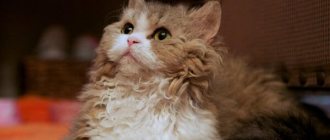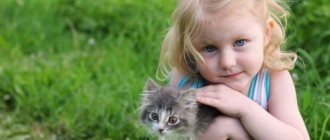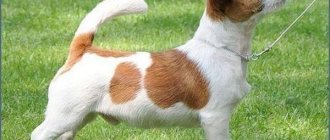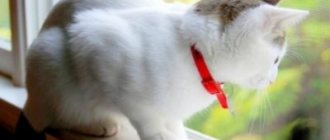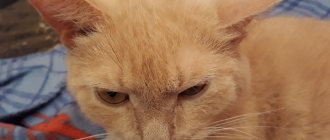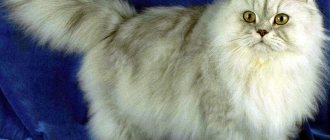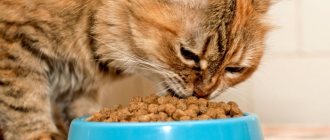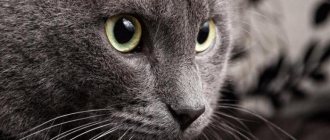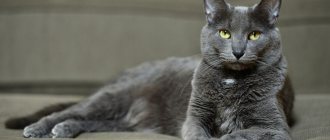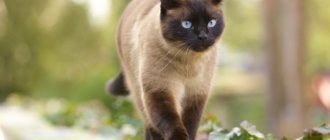The main representative of the short-legged cat breed is the Munchkin. These are one of the most interesting and cutest members of the cat family. Despite the fact that they became known relatively recently, they have already become famous and settled in the hearts of many people. Thanks to their unusual but very attractive appearance and friendly nature, little bundles of happiness will be welcome everywhere.
Munchkins are unusual but attractive cats
Short-legged pets are not only unusual in their appearance, but also in their origin story. In the article we will tell you how cats with short legs appeared, what are the characteristic features of animals, and types of breeds. You will also learn about keeping, breeding and choosing a kitten.
The history of cats with short legs
Mentions of cats with difficult appearance have appeared since the beginning of the nineteenth century in different parts of the world. The main feature was that the hind legs were normal, and the front legs were shortened. Cats appeared in England, Russia, Germany, and the states. Notes about unknown individuals were published in German and American magazines.
Every owner of a “cotognome” has probably heard of the name “Blackberry”. This is what music teacher Sandra Hochenedel from Louisiana named her cat. In 1983, a woman found a pregnant cat on the street and thought it was sick or seriously injured. But after the babies were born, Sandra realized that Blackberry was okay. Since almost the entire litter inherited a strong gene for short legs.
Munchkins resemble kangaroos in their habits
Munchkins are officially American, although they could be Russian. Even during World War II, kangaroo cats with shortened front legs were seen in Stalingrad. Sitting on their hind legs, the cats looked very much like a miniature Australian jumper.
Features of behavior
The tendency to sit on the hips and rest the tail on the floor is a striking behavioral feature that is dictated by the physiological limitations of the limbs. Cats of other breeds prefer to stand on their hind legs, but munchkins do not do this. The original pose often prompts owners to compare them with kangaroos, which also like to lean on their tail.
Munchkin on his hind legs
Character
The species is classified as a gentle breed that is distinguished by its calmness and good nature. They love affection and attention to themselves. There are a number of other features that owners like.
Munchkin morals:
- good manners (they rarely violate the rules established in the house);
- reasonableness (they quickly understand what is possible and what is not);
- devotion (they miss the owner if he is gone for a long time).
They can easily stand up for themselves, so their patience should not be tested. If the pet is not offended, then it will never act defiantly. Emotional dependence on a person is another characteristic that makes them change their mood quickly. Munchkins also become offended when they are ignored or ignored.
Munchkins quickly understand what is possible and what is not.
Fact. The breed is not vocal, except in varieties mixed with the Siamese cat.
Interesting facts about munchkins
Organization of personal space
Representatives of the breed are restless and quite active, so they love to play with their owner every day. This nuance of their character imposes responsibilities on the owners, who must devote at least half an hour to the animal every day. Attention helps your pet feel happy. In order for your pet to sometimes have fun on his own, you need to bring toys into the room, including a cat house that he can climb on. It will also help him sharpen his claws more easily.
Munchkins love to play with their owner every day
Attitude towards children
Thanks to the innate good nature, playing with the baby will not end with cuts, bites and a frightened look of the child. Cats also strive to communicate with humans, while not all purebred pets like prolonged communication with their owners. The species is very tolerant of the behavior of children, even if the child has a playful character.
Companion for a business trip or at home?
Most breeds do not do well with moving, while munchkins enjoy a change of environment. You can take them on a business trip or travel - a cat with this lifestyle will not become angry, but will look at and study the environment with interest. It is best to transport the animal in a carrier so that when it gets carried away by the world around it, it does not move dangerously far away from its owner. They should be walked on a leash, to which they quickly get used.
Munchkins love a change of scenery
What causes the appearance of short-legged cats?
The first time munchkins were revealed to people was at a regional cat show in 1991. At first, most viewers were very skeptical about this breed. Beauty is beauty, but what if these cats have a bad, unhealthy gene pool? But future research in the field of genetics has proven that the gene mutation that is responsible for the length of the legs is natural and has no connection with the animal’s poor health.
In 1991, munchkins appeared at an exhibition
In 1994, the TICA (The International Cat Association) took control of the breeding of this individual. In 1995, munchkins received official recognition, and in 2001, cats were brought to Russia for the first time.
So, what caused the appearance of these unusual creatures? The genetic dominant mutation turned out to be a spontaneous natural defect, which happens to domestic cats. The back and tail remained the same in shape and structure as those of ordinary cats. Shortened legs do not interfere with the life of these animals. The internal organs do not have any changes in shape or position. Simply put, the species appeared completely by accident as a result of crossing cats with shorter limbs with other domestic cats.
The gene that “shortens” the paws is called the achondroplasia gene, i.e. dwarfism with disproportionate limbs. Affects only the limbs.
Origin story
It is difficult to say where cats with short legs came from, but rumors about such animals have been circulating since the 18th century. Most often, such animals were considered underdeveloped for a number of reasons.
The Munchkin breed appeared in the thirties of the last century, but the war completely destroyed the animals bred by breeders, which stopped the experiments.
The ancestor of the real short-legged munchkin cat was Brambleclaw, Sandra Hochenedel's pet. A music teacher took in a stray cat and assumed that the short legs were the consequences of a hard street life.
When Ezhevichka had the same “low” kittens, Sandra turned to felinologists. It turned out that the cat and her offspring are carriers of a rare spontaneous mutation, the achondroplasia gene, that’s what the DNA section responsible for tiny limbs is called. The peculiarity of the breed is that it is highly dominant, so the selection of animals was not difficult.
In 1995, the breed was officially recognized.
Today the munchkin Albert is considered the most popular in the world. This cat has his own Instagram with half a million followers.
Description of munchkins
The main feature of this individual, of course, is its paws: with the naked eye it is clear that they are much shorter than those of ordinary cats. They are located symmetrically, with the hind legs slightly longer than the front ones. From the very birth of a kitten, you can understand that it is short-legged. By length they are divided into three types: regular, short, extremely short.
The classic munchkin is a bit like a barrel or a loaf of bread: the body is wide and round, small, but very strong. The chest is rounded, the back has a slight slope. The muscles are well developed. The muzzle is round and proportional to the body.
Munchkins are easy to distinguish from other breeds
The size is usually small, although kittens grow very quickly. At the withers the height reaches only fifteen centimeters. They weigh approximately 2 to 4 kg, depending on gender and age.
Widely set ears are round at the tips, medium or large. Semi-longhaired cats have tassels at the ends.
The eyes are large and beautifully almond-shaped in completely different colors, regardless of breed.
The small ponytail is also proportional to the body. Is in an upright position during activity.
There are three types of fur, like ordinary cats: long-haired, semi-long-haired (very soft) and short-haired, as if plush, with a medium undercoat. The fur color of these animals can be any color, since crossing occurs between different breeds.
Munchkins' fur can vary in length.
Distinctive features
The breed appeared relatively recently, so its standard has not yet been fully formed. However, the basic characteristics are already there:
| Sign | Description |
| Head | Wide, with smooth outlines, wedge-shaped. Proportional to the body. In adult males it is more developed than in females. |
| Nose | Average, slight bend allowed. |
| Ears | Located high. Fluffy, wide at the base, rounded at the tips. |
| Eyes | They have the shape of a walnut. Located widely, at a slight angle to the ears. The shade depends on the color of the coat. |
| Neck | Thickened and muscular, of medium length. |
| Torso | Medium size. |
| Paws | The hind ones are slightly longer than the front ones. It is permissible to bend the latter towards the inside. Limbs are straight. |
| Backbone | Not heavy, but not lightweight. |
| Muscles | Well developed. |
| Tail | Equal to the length of the body. Stands upright when moving. |
| Weight | In males - 3-4 kg. In females - 2-3.6 kg. |
| Wool | Short: shiny, plush to the touch. Long: dense and silky with a lordly collar. |
| Coloring | Any colors and combinations. |
Character and temperament
Cotognomists have an extremely friendly character. These cats are not prone to aggression. They can get along with absolutely everyone, so you shouldn't be afraid to get a pet if you have children or other animals.
Munchkins are very active and curious cats. They are responsive, love to play, run and jump a lot, and, despite their peculiarity, are surprisingly nimble and fast. It's very funny to watch them when they quickly move their little paws.
Munchkins are very active and love to play.
Cats are quite smart, so they quickly begin to follow the example of domestic cats. Kittens understand what can and cannot be done and are easy to train. Because of their curiosity, they love to carry things into their houses and can even build their own house. They quickly get used to a new place, love walks with a leash and can handle the road quite easily.
Munchkins are very smart and inquisitive
Very often, cats stand on their hind legs, folding their front legs on their chest. They can stand in this position for a long time, resembling meerkats in appearance.
Character traits
The short-legged Munchkin cat has a friendly disposition and always finds a common language with other pets: the cat’s dogs will not see her as a rival.
The pet respects its owners and easily adapts to the mood. Strangers also quickly establish contact with the kitten after seeing its feline charm and kindness.
Walking around the room, they stomp their feet like hedgehogs, which also lifts the mood. The cheerful, playful, easy-going nature of the munchkin will not leave anyone indifferent.
These cats are curious and friendly, love to play and easily tolerate the “squeezing” of children, do not show aggression towards other pets, but can catch smaller animals: birds and rodents.
The presented description of the breed shows that understated Munchkin cats can easily make friends not only with an adult owner, but also with a child.
Caring for a short-legged pet
These cats do not require any specific procedures. They love brushing, so try to care for the cats’ fur as often as possible and give them a kind of massage. In long-haired individuals, it is necessary to periodically comb out tangles, preferably with a furminator. The device resembles a razor or trimmer with very sparse teeth.
Munchkins love to be groomed
Munchkins are washed with individual shampoo every three months. It is necessary to rub your eyes and clean your ears. The procedures are quite simple to perform.
Use a cotton pad or cotton swab to wipe your eyes. The ears are also wiped with cotton pads soaked in a special solution.
Additional care should be taken for the teeth, as this individual is susceptible to tartar formation. They brush their teeth once a month using a special paste for cleaning cats’ teeth.
Nails are trimmed as they grow.
All of the above procedures can be carried out both in special animal salons and at home.
Care and maintenance
Munchkins do not require special conditions of maintenance; the rules of care are identical to the general requirements of other breeds.
Individuals with short hair are recommended to be brushed regularly, at least once a week. This procedure removes dead hair from the coat and maintains an ideal appearance. Long-haired munchkins need to be brushed more often - 2-3 times a week, preferably every other day. Thus, the animal’s fur will not roll into clumps and form unsightly tangles. If this happens, you need to carefully cut off the areas of fur that cannot be combed.
Like any other cat, munchkins require proper and balanced nutrition. It is necessary to visit the veterinarian periodically for a preventive examination and routine vaccination. And of course, the attention and affection of the owner - without them the animal is sad and yearning.
You should not bathe too often, especially if the cat lives in a house where there is no contact with street dirt or other animals. Hygiene procedures should be regularly carried out with the eyes, ears, and teeth of the animal. Caring for an animal consists of the following stages:
- Proper nutrition. Veterinarians do not recommend giving dry food to kittens of this breed. They have a predisposition to weight gain, so the munchkins' diet should be especially monitored.
- Carry out hygiene procedures regularly.
- Be sure to purchase a scratching post or carry out nail care several times a month.
- The munchkin should have its own corner where the animal will rest and be able to retire.
- It is necessary to carry out regular prevention of helminths.
- Using special shampoos to bathe the animal.
All these points must be fulfilled not only for the Munchkin breed, but also for all other pets.
Diet preparation
The diet of these animals should be carefully monitored and the method and type of feeding should be chosen wisely, because munchkins have a tendency to be overweight and can overeat.
The Munchkin's diet must be strictly monitored.
One option is to purchase “super-premium” food for a certain age, which contains all the necessary vitamins and microelements. Or feeding with natural food in the proportion of 60/30/10%, respectively, meat (poultry)/vegetables/cereals, that is, a balance of protein, fat and fiber. Fatty, smoked and sweet foods should not be given. Change the water every day so that it is fresh and there is access to constant drinking.
Kittens are fed 5 times a day, from four months the amount of food is slightly reduced, and an adult cat is fed two to three times a day.
Feeding the munchkins
It is vital for this cat to maintain a proper and balanced diet. It must be selected and meet certain requirements:
- do not overfeed;
- the base must be protein (animal protein);
- fibers of plant origin are poorly digested;
- a minimum of carbohydrates in food, which will not lead to excess body weight;
- You cannot feed your cat dry food and natural food at the same time;
- food from the common table is harmful for this breed.
It is also worth noting clean water: the cat must have constant access to it.
Feeding with natural products
This diet should consist primarily of meat and poultry. It is better to choose varieties that are hard or contain cartilage and tendons. Tenderloin, sirloin, chicken breasts are not recommended for munchkins. The meat is boiled and added to the porridge. It will be useful to add dairy and fermented milk products to your diet, such as cottage cheese or kefir. There is no need to give milk to adults - the body does not absorb it. Whole milk is given only to kittens.
It will be useful to include fish containing fatty acids in your diet. These varieties are red fish - trout, salmon and others. It is also advisable to give it boiled. For variety, the cat should receive eggs, organ meats, and vegetables (low in starch). The frequency of feeding depends on the age of the cat.
Adult animals need to be fed 2-3 times a day, adjusting the portion size. Kittens over 2 months old receive food 5 times. After four months, the frequency of meals is 3-4 times a day.
Feeding with natural products must be balanced.
What not to give
Any river fish is prohibited. It contains a high content of helminth parasites and a lot of bones. It is necessary to give sea fish to the animal, but not more than a couple of times a week, so as not to provoke urolithiasis. It is also prohibited to give your pet:
- sweet;
- flour;
- fatty meats and fatty cuts;
- beans;
- vegetables containing starch;
- bones.
These products can lead to the development of a number of diseases in your pet.
How to feed a munchkin kitten
Kittens require special nutrition or special food that is high in calories and nutrients required for intensive growth. The main part should consist of boiled meat, cereals, and vegetables.
Interesting read: everything about the character and habits of Maine Coons.
Diseases of cats with small paws
One of the more likely diseases that can affect this breed is lordosis. This disease can appear both for a genetic reason and, for example, due to excess weight. It is a strong curvature of the spine that descends and puts pressure on the internal organs.
The breed is prone to obesity, which can lead to lordosis
Diseases common to the entire cat family can be avoided by getting all the necessary vaccinations. Not only will this prevent illness, but also help prolong the life of your pet. They can live up to 14–16 years.
Munchkin health
The breed's gene pool is still actively expanding. The munchkin's health is good; cats have a strong immune system, so with proper care, comfortable housing and a balanced diet, they live up to 16 years. Achondroplasia (short stature) does not have a pathological effect on the joints. Animals do not suffer from painful spasms and maintain mobility throughout their lives.
To prevent viral diseases, it is recommended to follow the vaccination schedule. In addition to the required vaccines, the veterinarian may recommend vaccination against infections specific to the place of residence.
Vaccination is considered mandatory even for those who never go outside. Pathogenic microorganisms are carried on shoes and clothing, and transmitted through rats and other animals. In addition to vaccinations, cats must be regularly treated for fleas and helminths.
Possible diseases
The only disease characteristic of the breed is congenital or acquired lordosis. The pathology is accompanied by weakening of the muscles that support the spinal column. If a kitten is born with such a disease, then the constant pressure of the spine on the chest organs leads to death.
With a slight curvature, the heart and lungs do not suffer, but the disease can worsen due to negative factors: obesity or injury. If lordosis does not reduce the quality of life, then treatment is not applied. The disease is rare and can occur in any other breed of cat.
Reproductive health
The age of the first estrus is 6-8 months. The pet becomes more affectionate, rolls on the floor and moves its tail to the side when pressing on the sacrum. To prevent cancer and pathologies of the urinary system, veterinarians recommend castration and sterilization. The operations are suitable for all animals older than 6-8 months that are not involved in breeding.
If the owner plans to procreate, then he needs to study the nuances of mating munchkins. The offspring can consist of kittens of 2 types:
- standard ones with short legs;
- non-standard, having paws of medium length.
Non-standard munchkins are awarded a pet or breed class. They are not allowed to participate in exhibitions, but access to breeding remains open. Acceptable matings suggest the following patterns:
- Standard + non-standard. A cat gives birth to kittens with different types of limbs. Some of the genes responsible for achondroplasia are suppressed. Long-legged offspring outnumber short-legged ones.
- Non-standard + non-standard. Due to the absence of achondroplasia genes, all kittens are born with normal paws. This mating is used to increase the total number of individuals, since at the birth of kittens the maximum number within the litter is noted.
- Standard + standard. Embryos that inherit 2 achondroplasia genes are resorbed during pregnancy. The number of offspring is minimal. A cat gives birth to kittens with different paws in equal percentages.
Interestingly, the effect of the recessive dwarfism gene is completely reversed due to a mutation that has arisen in its code.
Immediately after birth, kittens cannot stand on their legs, so they move by crawling. Unlike swimmer's syndrome, normal limb function returns on its own.
The work of breeders aimed at breeding the breed led to the creation of hybrid species. Short-legged cats, very different from the standard, were dubbed "dwarves." These include bambino, elves, kinkalows, napoleons and many others.
Education and physical activity
Munchkins are very smart and trainable cats. Since childhood, they are very curious and remember the habits of those around them.
Due to the limitations of their physiological capabilities, cats cannot climb or jump high, so from the very beginning you need to take care of a place to sleep, preferably closer to your bed. Buy a tray with low sides.
As already mentioned, the main causes of lordosis are obesity and a sedentary lifestyle. You should not overfeed the animal, play with it more often, especially since they love it. Love for walks gives you the opportunity to move a lot. You can walk if you have a leash.
You can walk munchkins on a leash
Install a scratching post that is suitable for the height and buy toys to attract the attention and develop the activity of the little cat.
Breeding
Breeding this breed contains many nuances. For independent breeding, it is recommended to undergo special training. Only professionals who understand the genetics of cats will be able to competently breed these cats.
There are two types of short legs: standard and non-standard. The first ones have short legs, the second ones have long legs. For a better genetic background, mating of both species can be allowed. But if the baby receives both dominant signs of short legs, it will die while still in the embryonic stage. This is one proof that breeding is best left to experienced, knowledgeable people.
In Russia, munchkins are bred only in three cities. All necessary documents for animals can be obtained in Moscow, St. Petersburg or Novosibirsk.
Breeding
An unusual fact in the development of long-haired and short-haired forms of the breed is crossing with outbred cats . As a result, the solid color is less common compared to the tabi color.
When munchkins mate with each other, all kittens have short legs. But in the first generation, when munchkins mate with ordinary cats, there are no results.
Until recently, it was difficult to purchase a munchkin kitten in Russia. Today you can buy a purebred pet from a breeder in almost every major city in the country.
Thus, there are several nurseries in Moscow, the largest of which are Sunny Fairies and Murmulet; you can also apply for a kitten at Super Munchkin, which is located in St. Petersburg.
In addition, kittens with a pedigree are sold in the Iberis nursery in the city of Magnitogorsk and in similar organizations in Tyumen, Kaliningrad, and Yekaterinburg. Due to the fact that kittens sell out quickly, the animal can be reserved in advance.
Kittens from nurseries are sold only after castration or sterilization, in order to prevent mating with other animals, as this is harmful to the development of the breed.
If the presence of a pedigree is not important for future offspring, then a mating partner is found from among ordinary cat owners. It is important that the partner does not have the dominant gene responsible for the appearance of short legs.
Rules for choosing a kitten
You should buy a cat of this breed only in specialized nurseries, where the owners are well versed in the genetics of cats and fully know their business. Only in such places can you buy a real purebred animal. It’s better not to take cats from supporters. The small creature may resemble the representative, but what it will grow into is not known.
The average price for a baby munchkin is around 25,000-50,000 rubles.
Kittens should be purchased from nurseries
Most often, nurseries already have a list of names suitable for the breed, or breeders themselves indicate the name in the metric, selected according to the pedigree. But at home, you can choose a nickname for your pet yourself.
On the practical side, you need to choose a kitten according to the following criteria:
- A very small kitten will be a dwarf. The body and head should be of normal size.
- The tail is straight without bends, the legs are straight.
- Clean eyes, nose, fur.
Trusting your intuition, you should choose the most active kitten. On the one who will reach out to you. When I chose my cat, the choice was between six kids. Here he was, a little lump that jumped onto the table in front of me, lay down, stretched out and waited to be petted. Who else could I take?
Buying a kitten
It is recommended to buy a Munchkin kitten only from trusted breeders.
Munchkin kitten
Before choosing a baby, you should decide what kind of pet you want to buy: with short or elongated limbs, short-haired or long-haired, etc.
What to pay attention to
It is better to choose parents at the exhibition. There you can evaluate the exterior of the animals and hear the opinion of an expert. When purchasing, you should ask the breeder about hereditary diseases.
It is also necessary to clarify whether the kittens have been dewormed and vaccinated.
Reference! Each baby must have a metric, which is subsequently exchanged for a pedigree.
Kitten price
The cost of a munchkin kitten varies from 15 to 50 thousand rubles.
The most expensive are the show-class ones with short legs. “Non-standard munchkins” with elongated limbs have a lower cost - from 15 to 20 thousand rubles.
